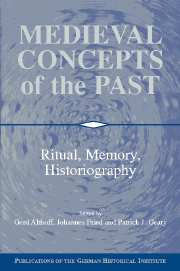Book contents
- Frontmatter
- Introduction
- 1 Authority and Legitimation of Royal Policy and Action: The Case of Henry II
- 2 King Henry II of Germany: Royal Self-Representation and Historical Memory
- 3 The Variability of Rituals in the Middle Ages
- 4 Rebels and Rituals: From Demonstrations of Enmity to Criminal Justice
- 5 Oblivion Between Orality and Textuality in the Tenth Century
- 6 Text and Ritual in Ninth-Century Political Culture: Rome, 864
- 7 The Concept of Time in the Historiography of the Eleventh and Twelfth Centuries
- 8 Constructing the Past by Means of the Present: Historiographical Foundations of Medieval Institutions, Dynasties, Peoples, and Communities
- 9 Topographies of Memory: Center and Periphery in High Medieval France
- 10 Challenging the Culture of Memoria: Dead Men, Oblivion, and the “Faithless Widow” in the Middle Ages
- 11 Artistic and Literary Representations of Family Consciousness
- 12 The Strange Pilgrimage of Odo of Deuil
- 13 The Rhineland Massacres of Jews in the First Crusade: Memories Medieval and Modern
- 14 The Martyr, the Tomb, and the Matron: Constructing the (Masculine) “Past” as a Female Power Base
- Index
11 - Artistic and Literary Representations of Family Consciousness
Published online by Cambridge University Press: 05 January 2013
- Frontmatter
- Introduction
- 1 Authority and Legitimation of Royal Policy and Action: The Case of Henry II
- 2 King Henry II of Germany: Royal Self-Representation and Historical Memory
- 3 The Variability of Rituals in the Middle Ages
- 4 Rebels and Rituals: From Demonstrations of Enmity to Criminal Justice
- 5 Oblivion Between Orality and Textuality in the Tenth Century
- 6 Text and Ritual in Ninth-Century Political Culture: Rome, 864
- 7 The Concept of Time in the Historiography of the Eleventh and Twelfth Centuries
- 8 Constructing the Past by Means of the Present: Historiographical Foundations of Medieval Institutions, Dynasties, Peoples, and Communities
- 9 Topographies of Memory: Center and Periphery in High Medieval France
- 10 Challenging the Culture of Memoria: Dead Men, Oblivion, and the “Faithless Widow” in the Middle Ages
- 11 Artistic and Literary Representations of Family Consciousness
- 12 The Strange Pilgrimage of Odo of Deuil
- 13 The Rhineland Massacres of Jews in the First Crusade: Memories Medieval and Modern
- 14 The Martyr, the Tomb, and the Matron: Constructing the (Masculine) “Past” as a Female Power Base
- Index
Summary
Karl Schmid deepened our understanding of the German nobility's changing self-consciousness between the tenth and thirteenth centuries, most brilliantly, perhaps, in his article on the Welfs' rewriting of their dynastic history. Although critics have challenged and modified many of Schmid's specific points, it is clear that there was a change in family structure from amorphous sips composed of individuals who could claim kinship, whether agnatic or cognatic, with a powerful magnate to patrilineal dynasties that were often identified with the fortified center of the lineage's lordship, such as the Habsburgs. This transformation was both a cause and a consequence of the process of territorialization and occurred, as the work of Georges Duby has made clear, at the expense of daughters and younger sons.
In this chapter I look at three highly problematic and disparate artistic and literary texts that can be read as reflecting the tensions caused for and within noble or formerly noble families by the strengthening of princely authority. Each work was a response to a painful and troublesome past and an attempt to shape the lineage’s future destiny. What the three pieces have in common is that each was produced by a man and/or woman who was or who perceived himself or herself as a loser or potential victim in the formation of the territorial principality. I focus primarily on the family portrait in the Codex Falkensteinensis that was drawn at the behest of Count Sigiboto IV of Falkenstein and that has aroused surprisingly little scholarly interest.
- Type
- Chapter
- Information
- Medieval Concepts of the PastRitual, Memory, Historiography, pp. 233 - 252Publisher: Cambridge University PressPrint publication year: 2002



